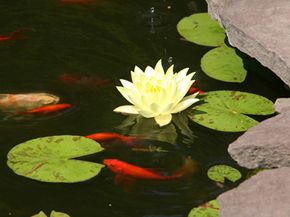Pond Flora and Fauna
Your pond is finished, but it's not complete until it supports life -- the swimming kind, the blooming kind or both.
Before you add fish to your pond, the water needs to mellow into something more natural than tap water. While it was settling into your liner, it was also ridding itself of chemical additives like chlorine that are harmful to fish and plants. Cycle the water through your filter system and check your pump operation for at least a week before introducing fish.
Advertisement
Meanwhile, you can landscape your pond. If you've built a koi pond, you'll add plantings around the pond and possibly a few container plants on the plant ledge. If you're including goldfish in a water garden, get the plants in now to oxygenate the water and control algae growth. Pond plants that require soil will need to be potted in pond-safe containers with a layer of gravel on top to keep the soil from floating away in the water. Examples of these plants are: water lilies, a floating leaf plant; arrowhead, a plant that grows at the edges of ponds; and curly pondweed, a fully submerged plant. Floating plants, such as water hyacinths, have trailing roots that take nutrients directly from the water.
When you're ready to add fish, check the pH of your pond water with a commercially available kit. Koi and goldfish thrive in neutral to slightly alkaline water, pH 7 to 8 [source: Nash]. Introduce fish over a period of days or weeks up to or below the fish stocking level for your pond. To determine how many fish you can have, allow 5 gallons (19 liters) for each inch (2.5 centimeters) of goldfish. Koi need twice that volume [source: Nash]. Remember that fish grow, so figure your stocking level for adult size fish.
Your fish don't really need hiding places. Pond plants provide shade, food and shelter for goldfish. The depth and shady location of koi ponds provide protection from predators and sun exposure. If you decide to give them a bolthole, make sure that anything you put in the pond is smooth and rounded. This will protect both your fish and the pond liner.
Learn how to keep your pond in good condition on the next page.
